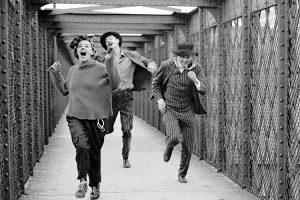In some circumstances, conflict brings resolution, criticism gives way to celebration, and formula is abolished by experiment.
Welcome, the French New Wave.
While not an official movement, the term was coined by film critics who had to describe a group of groundbreaking French filmmakers from the 1950s and ‘60s. The movement was gestated after these particular French filmmakers denounced mainstream cinema’s “Tradition of Quality,” which preferred convention over innovation, and the old over the new.
French New Wave is an important period in cinema history because, in the simplest of explanations, it changed everything. Up until that time, cinema was grand – the art form was a process heavily financed, rehearsed, and photographed. Epics like “Gone With the Wind” and “Giant” were so standard that when a film shot in an almost documentary-style was released, audiences paid close attention. It looked different. It sounded different. It felt different. But thankfully, it caught on.
The use of portable camera equipment and actors speaking dialogue drenched in sarcasm were the first characteristics of this new breed of cinema. There was humor within the New Wave celluloid, and an intense focus on the absurdity of the time’s social revolutions.
So much of what was invented in French New Wave, and what has endured in its association, has remained in filmmaking today. The long tracking shots, the jump cuts, the privilege in allowing actors to improvise. Having influenced masters and novice filmmakers, it’s important to recognize those who pioneered this substantial advancement in cinema.
There are two writer/directors who are most significant – Francois Truffaut and Jean-Luc Godard. Both Truffaut and Godard started as film critics for the magazine Cahiers du cinema, writing on their fondness for when a film director’s personal vision is reflected onto the screen.

Once given the opportunity to make their own films, Godard and Truffaut were then the ones to rise with the term “auteur.” They became the authors of their own movies, making it openly known that their personal influences affected their art’s style and words. While some films are more personal than others, each director made one film that defines the new wave movement: “Jules and Jim” and “Breathless.”
Godard’s 1960 film “Breathless” is special for many reasons. It’s Godard’s feature-length directorial debut and, more importantly, it’s the most influential French New Wave film. “Breathless” goes against every established grain in the art of filmmaking. It became a blueprint for Godard’s fellow renegades to work from, molding their own perspectives into a similar format.
It certainly impacted Truffaut’s 1962 film, “Jules and Jim,” which tells the story of two male friends who get involved in a tragic love triangle when falling for the same woman. While the premise may seem familiar, the style in which the film is composed was anything but for a picture of that time. Truffaut, keeping in line with the movement’s belief of innovation over tradition, threw everything against the wall to see what would stick. The incorporation of freeze frames, newsreel footage, transitional wipes, and panning shots were all jarring visuals to an audience, however, incredibly impressive.
In fact, so many of the stylistic choices seen in both “Jules and Jim” and “Breathless” are still seen in films today.
“Goodfellas,” for example, is a modern film that stylistically and visually tells a similar story to those of the French New Waves. And along with the revolutionary storytelling techniques came a certain character complexity – specifically for women.
For the first time, women were portrayed as being cerebral. It was the beginning of intellectual and artistic sexiness. Their sensuality came to surface through their complications not just through sultry stares and shifts in their bodies. The French New Wave roles for actresses were as intricate and strong as the personalities they were to play against – the men’s.
If the French New Wave could be compared to music, it would be the film industry’s rock ‘n roll. It was and still remains to be incredibly sexy in its rebellion. It has as many devotees as those who oppose it, and just like rock ‘n roll, it’s incredibly poetic in structure yet loud in emotion.
It remains my favorite type of cinema thanks to its bravery, its distinctiveness, and lastly, its longevity. French New Wave is a home for outsiders, for individuals seeking more than the ordinary. It’s the very reason why a person like me is able to have a career in film at all.
Ashley Peter writes the Reel Remarks column in the Two River Times. She is a writer and Two River area native who works in the film and television industry.














